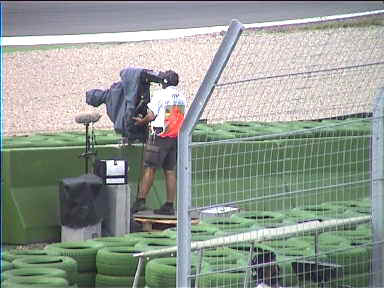 Formula One has become so popular around the world because it is on television. Every other weekend during the season, which lasts from March to October, you can find Formula One qualifying sessions and races broadcast live on many terrestrial channels around the world. So, even if you are on holiday in a foreign country during the summer, keeping up to date with what is happening in Formula One is very easy. Very useful! But race coverage is not the only way that millions of fans around the world can follow the sport. You can find several analysis programmes on cable and satellite television that cover the latest news � as well as behind-the-scenes features and interviews.
Formula One has become so popular around the world because it is on television. Every other weekend during the season, which lasts from March to October, you can find Formula One qualifying sessions and races broadcast live on many terrestrial channels around the world. So, even if you are on holiday in a foreign country during the summer, keeping up to date with what is happening in Formula One is very easy. Very useful! But race coverage is not the only way that millions of fans around the world can follow the sport. You can find several analysis programmes on cable and satellite television that cover the latest news � as well as behind-the-scenes features and interviews.Formula One�s bosses are well aware that the key to the sport�s popularity is that it has worked so well as a television concept. These days the format for coverage is the same for every race, and it sometimes means that a driver�s duties for the cameras are more important than speaking to friends and family. After the race, for example, the drivers are whisked up to the podium as quickly as possible, where they receive their winners� trophies and spray the champagne. But before they can go back to the team and receive more congratulations, they�re ushered off to a special room where they are interviewed for international television coverage. These interviews are very often the first words the drivers speak after the race � and millions of fans at home can often find out things before the drivers� own team boss knows them. This is the perfect chance for the sponsor logos of the driver to be shown to millions of fans around the world � as well as the title sponsors who back the actual Grand Prix.
In addition, the increase in television technology now means that in-car cameras are a regular feature of practice and race coverage, with sponsor logos positioned for maximum television exposure. You can also listen in on radio conversations between the pits and the driver in the car as they actually happen. Driver interviews take place immediately after the race, but television crews can speak to engineers and team bosses in the pits to try to help viewers understand race tactics as the Grand Prix is actually in progress. Nowadays, the coverage is not just restricted to television though. If you�re not sitting watching television, you can find out what�s happening in Formula One in a few other ways too:
- Radio stations, especially those devoted to sport, give up-to-the-minute reports on the latest news and several include chat and analysis shows with commentary from experts, former drivers and other leading personalities.
- Newspaper coverage is still increasing and, specialist magazines provide even more in-depth coverage.
- The Internet has expanded so much in recent years that hundreds of sites now cover Formula One. In the future, Internet technology may allow Formula One fans to get even closer to the action. There is talk of a computer game that will allow those playing it to actually take part in a �virtual� Grand Prix as it actually happens in real life, while timing screens and other vital statistics can already be downloaded as they happen.

















No comments:
Post a Comment